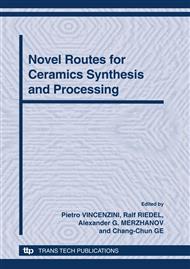p.141
p.147
p.152
p.158
p.164
p.170
p.175
p.181
p.187
Influence of Binder on Porous Ceramic Properties Prepared by Polymeric Sponge Method
Abstract:
Porous ceramic materials are used in medicine as well as in industry. They can be prepared in the form of filter components, thermal insulators, or composite components. Preforms of this type can only be applied if they meet the respective structural requirements. In the present study, such a porous ceramic material was produced by the polymeric sponge method using a polyurethane sponge and a-Al2O3 Almatis. The aqueous suspension was prepared with binders of the two types: polyvinyl alcohol and a dispersion based on methacrylic acid esters and styrene. The aim of this study was to find the relationship between the composition of the weight slips, sintering conditions, and the structure of the porous ceramic obtained. The paper presents the results of studies on the rheological properties of the ceramic slurries and the results of strength tests of the ceramic material.
Info:
Periodical:
Pages:
164-169
Citation:
Online since:
October 2010
Price:
Сopyright:
© 2010 Trans Tech Publications Ltd. All Rights Reserved
Share:
Citation:


